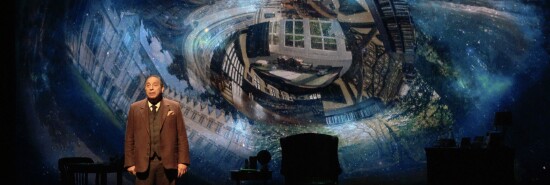
In Further Up and Further In, C.S. Lewis comes to life
Madeline Fry Schultz
Video Embed
In The Silver Chair, the fourth book in C.S. Lewis’s Narnia series, the schoolgirl Jill encounters Aslan at a stream. She tells the lion that she’s dying of thirst but, intimidated by his presence, asks him to leave so she can drink. He refuses.
“‘Oh dear!’ said Jill, coming another step nearer,” Lewis writes. “‘I suppose I must go and look for another stream then.’” To which the lion replies, “There is no other stream.”
REPUBLICAN PRIMARY: BIG TENT OR BIG TOP?
This story — which concludes Max McLean’s production of Further Up and Further In, a play about the beloved Narnia author and theologian — beautifully sums up Lewis’ approach to faith, as well as McLean’s brilliant interpretation of it.
In Further Up and Further In, a 90-minute, one-man production written and performed by McLean, the actor explores the person and faith of Lewis. The play is something of a sequel to The Most Reluctant Convert, another production from McLean and Fellowship for the Performing Arts, which focuses on Lewis’ conversion.
Showing now through June 18 in Washington, D.C., Further Up and Further In digs into the life and loves of a beloved author. To the Christian community, Lewis is something like the patron saint of pilgrims and pipe smokers, and the nearly packed theater on opening night in D.C., a Wednesday, signified that 60 years after his death, his popularity hasn’t waned.
At an hour and a half with no intermission, the play goes by surprisingly quickly. At the outset, McLean briefly outlines the questions Lewis wrestled with as he came to faith and then spends a good portion of the play reciting a back-and-forth correspondence between a young skeptic and Lewis himself. While Lewis had found himself wishing Christianity wasn’t true but concluding that it was, his young protégé writes that he hopes Christianity to be true but isn’t sure if he can believe it. “The Holy Ghost is after you,” Lewis concludes. “I doubt you’ll get away.”
Drawing dialogue from Lewis’s writings and collected letters, edited by McLean to trim length and make the script more conversational, Further Up and Further In paints Lewis as a pilgrim and an intellectual; though Lewis admits he prefers the “head stuff” to the “heart stuff,” he cannot help but earnestly share his faith with any who would ask to hear it.
During the play, McLean — that is, Lewis — meanders between just three set pieces: a dresser (which houses his beloved whiskey and port), an armchair, and a desk, from which he responds to letters from those wishing to learn more about his conversion to Christianity.
The script may feel a bit heady at times, but, well, that’s Lewis. Though known for the accessibility of his theological works, such as Mere Christianity and The Screwtape Letters — as well as, of course, the Narnia books that were written for children — Lewis can still at times feel like he’s lost in the abstract.
In a Q&A session following the play, McLean noted that Lewis’ “constellation of ideas … touches synapses in the brain that don’t often get hit.”
Nevertheless, his discourses on prayer, on the divinity of Christ, and the meaning of the Second Coming are meant to be accessible to a broad audience. In the play, McLean hopes to make them more so. As art, he said, the aim of the play is “not to give the final answer but to get you further up, further in.”
This phrase, the title of the play, references a scene from the final installation in the Narnia series. A note from Fellowship for the Performing Arts explains, “The title of the new work Further Up & Further In is drawn from a phrase used 14 times in Lewis’s The Last Battle. It’s also a major theme of The Great Divorce as the visitors to heaven are invited to travel further up the mountain, climbing ever higher into God’s kingdom.”
CLICK HERE TO READ MORE FROM THE WASHINGTON EXAMINER
This driving principle keeps the play from meandering too much, focusing merely on providing a glimpse of Lewis as a man of faith. McLean achieves this aim, masterfully adopting Lewis’s mannerisms and tone, and offering more than mere trivia for Lewis’ fans and newcomers alike.
“I want you to believe I’m C.S. Lewis,” he said after the play. For an hour and half, you do.
